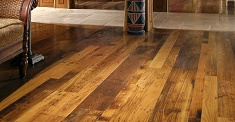 NATIONAL REPORT—When the NoMad Hotel opened in New York City in 2012, it did so with reclaimed wood flooring in its guestrooms. When the Grain Tasting Bar opened late that same year at the Hyatt Regency Vancouver in British Columbia, it featured doors made from reclaimed wood. When the Heritage Cabins at Pine Bungalows in Jasper National Park in Alberta, Canada were completed this year, the knotty pine tongue-in-groove wood installed in the original Pine Bungalows cabins in the 1960s and 1970s was utilized. Reclaimed wood is increasingly being specified and used in lodgings of all types, whether in flooring, doors, mantels, paneling, menu covers, or other fixtures or accessories.
NATIONAL REPORT—When the NoMad Hotel opened in New York City in 2012, it did so with reclaimed wood flooring in its guestrooms. When the Grain Tasting Bar opened late that same year at the Hyatt Regency Vancouver in British Columbia, it featured doors made from reclaimed wood. When the Heritage Cabins at Pine Bungalows in Jasper National Park in Alberta, Canada were completed this year, the knotty pine tongue-in-groove wood installed in the original Pine Bungalows cabins in the 1960s and 1970s was utilized. Reclaimed wood is increasingly being specified and used in lodgings of all types, whether in flooring, doors, mantels, paneling, menu covers, or other fixtures or accessories.
The motives for using reclaimed wood are many. Environmentally, wood taken from existing structures or even river bottoms can have many advantages. Virgin or farmed forests are not cut down and wood is diverted from the landfill. The more local the sourcing, the greater the environmental upside. For the owner of the structure, there are cost savings from not having to dispose of the wood. Aesthetically, reclaimed wood cannot be beat for offering an aged appearance to a setting. Structurally, old reclaimed wood tends to have a much tighter grain structure and is more stable than virgin wood of the same species. From a marketing standpoint, there can be fascinating stories behind the wood worth retelling over and over.
Knowing the source of the reclaimed wood that one purchases can be tricky but most suppliers to the hospitality industry well document the source of their product—on their websites and internally through branding and other processes. The Forest Stewardship Council (FSC), according to Brad Kahn, the organization’s Communications Director for the United States, certifies not only companies selling reclaimed wood but also the individual products themselves.
Thousands of Companies FSC Certified
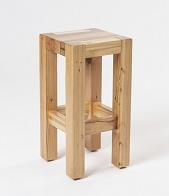 “There are 29,000 companies FSC certified, the majority of which are chain of custody certified,” Kahn says.
“There are 29,000 companies FSC certified, the majority of which are chain of custody certified,” Kahn says.
FSC has several recycled product labels. Their FSC Recycled label is the label to look for when considering reclaimed wood.
“The FSC label tells the customer it is reclaimed wood and someone has verified it,” Kahn says.
Companies earning the FSC label must adhere to FSC standards and hire an auditor to ensure best practices are being followed.
“‘Reclaimed’ is more of a book audit,” Kahn says. “It feeds into LEED. You can earn credits in the LEED system for it. LEED does drive a lot of these decisions.”
Kahn says FSC does not set standards for deconstruction—the process by which reclaimed wood is generated.
An increasing number of companies now offer wood reclaimed from barns, factories and other sites. The following is a list of some of the companies that either specialize in hospitality or participate in some hospitality projects.
Rustbelt Reclamation, according to Chase Horsburgh, Principal, V.P. of Business Development, manufactures all of its products from reclaimed materials set for demolition. The addresses of salvage sites are listed on the company’s website.
Company Employs Harvesting Manager
“We have a full-time harvesting manager,” Horsburgh says. “He spends all of his time chasing down leads on reclaimed materials. We work with several demolition contractors. We will go into the structure several days prior to demolition to get the wood we need.”
The wood is photographed at the demolition site, crated, taken back to a warehouse, numbered, and placed in inventory. The harvest location and species are inputted into an inventory tracking system.
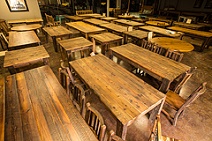 “We take material through our processing department where it is de-nailed,” Horsburgh says. “We cut it to length. We use a metal detector over it and take moisture readings. Once we use [a piece of wood] to construct a job, we insert a coin in it that states the salvage location—a circular wooden coin. The end user can go on our website and search the location. We are really all about telling a story.”
“We take material through our processing department where it is de-nailed,” Horsburgh says. “We cut it to length. We use a metal detector over it and take moisture readings. Once we use [a piece of wood] to construct a job, we insert a coin in it that states the salvage location—a circular wooden coin. The end user can go on our website and search the location. We are really all about telling a story.”
Rustbelt Reclamation offers furniture including desks, tables, stools and other items.
“As the sustainability movement forages ahead, the consumer’s desire for reclaimed product will continue to grow,” Horsburgh says. “It is becoming a bigger trend. Every new restaurant is using reclaimed materials.”
Old World Reclaimed Woods offers beams, planks, siding, flooring, mantels and other items. Barns are the primary source for the company’s wood. According to John Israel, the company’s President, wood has been acquired from five barns and one factory so far.
“We make box beams,” Israel says. “We do flooring, mantels. We are starting to get into furniture.”
Israel says reclaimed wood is a superior green option to wood grown on farms with fertilizer.
In regard to tracking, he says his company places the name of the barn on the wood sold. Sometimes, he says, one can go to Google Maps and still see the barn standing.
FSC Certified Flooring, Paneling
Carlisle Wide Plank Floors offers a selection of FSC certified wood flooring and paneling made from reclaimed wood. “Grandpa’s Floor,” one of the company’s product lines, features original stains, watermarks and saw kerfs.
Viridian Wood Products makes some of its products, which include tabletops, flooring, paneling, beams and decking, from shipping dunnage, pallets and dimensional wood used for crating. The company’s reclaimed wood flooring, prefinished engineered flooring and paneling come from a variety of sources throughout the West, including abandoned buildings, shipyards, old docks and wine casks. All of the company’s products are FSC certified.
Reclaimed Table, a member of the U.S. Green Building Council, creates furniture and fixtures from reclaimed wood from barns and other retired buildings. Like other companies that utilize reclaimed wood, Reclaimed Table sources, designs and produces all of its products in the United States.
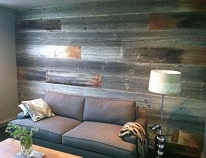 Sustainable Flooring’s reclaimed woods can be divided into two categories—those sourced from old structures and those recovered from river bottoms. The “old structure” reclaimed wood is barn wood that has been reclaimed through deconstruction and then milled into flooring. The dredge wood is reclaimed from the bottom of riverbeds throughout North America.
Sustainable Flooring’s reclaimed woods can be divided into two categories—those sourced from old structures and those recovered from river bottoms. The “old structure” reclaimed wood is barn wood that has been reclaimed through deconstruction and then milled into flooring. The dredge wood is reclaimed from the bottom of riverbeds throughout North America.
“Most of our reclaimed material is about 25 percent harder than traditionally available wood of the same species, and more stable—since the growth rings are tighter,” says Pete Nichols, President and owner of Sustainable Flooring.
“Our reclaimed Strandwoven TIMBER, made from post-industrial reclaimed/recycled veneers from the furniture manufacturing industry, uses recycled by-product, which is compressed together, and then milled into flooring,” Nichols says. “This produces a product about four to five times as hard as the original species input, and is much more stable (moves less with changes in relative humidity), and produces a tight-grained aesthetic unseen in traditionally harvested woods used for flooring.”
Interest in Reclaimed Wood Increasing
Nichols says his company is seeing more interest in reclaimed wood from those in the hospitality space. “More clients value products with a sustainable story than they used to,” he says. “And, when you can add product features (such as greater durability and stability), it somewhat makes it a no-brainer.”
When asked what one should look for when considering reclaimed wood, Nichols emphasized making sure the species of product meets the application. “For a high-traffic area in a high-traffic hotel, it might not be a good idea to put down pine,” he says.
Mountain Lumber’s reclaimed flooring selection includes antique heart pine, oak, chestnut and other hardwoods rescued from historic structures slated for demolition. According to the company, it burns the dust by-product from manufacturing to create the energy used to run kilns and heat its facilities. Railroad cars in Russia and original Guinness beer vats from Dublin, Ireland are two of the sources for the reclaimed wood used in Mountain Lumber’s products.
Eco Friendly Flooring’s reclaimed wood flooring is milled from structural beams and timbers that were used in warehouses and factories in the early 1900s. Some of the flooring has also been salvaged from tongue/groove planks that lived their previous life also as flooring.
Yesteryear Brand Flooring
 Aged Woods’ reclaimed wood flooring comes from agricultural out-buildings, i.e. barns, ranging in age from 75 years to as much as 200 years. Yesteryear brand flooring is made from specially selected, recently harvested wood. In late 2007 the company introduced ERA—Engineered Reclaimed Antique—flooring. This product has a 3mm wear layer of reclaimed antique wood over a nine layer substrate of fast-growing birch held together by formaldehyde-free adhesive.
Aged Woods’ reclaimed wood flooring comes from agricultural out-buildings, i.e. barns, ranging in age from 75 years to as much as 200 years. Yesteryear brand flooring is made from specially selected, recently harvested wood. In late 2007 the company introduced ERA—Engineered Reclaimed Antique—flooring. This product has a 3mm wear layer of reclaimed antique wood over a nine layer substrate of fast-growing birch held together by formaldehyde-free adhesive.
Parquet By Dian works with suppliers of reclaimed woods for the flooring that it makes.
Pioneer Millworks uses reclaimed wood in products such as flooring, paneling and siding and has salvaged jarrag wood from businesses in Australia and boards from a Chicago meatpacking plant. Workers regularly dismantle wine barrels made with redwood, cypress and Douglas fir from Finger Lakes wineries. The company has kept 20 million board feet out of landfills. Boilers burn the company’s waste wood to power its kilns and heat its shop. No smoke or ash is generated because of the extremely high temperatures. Sawdust is recycled into pellets for home heating, electricity is generated through wind power, and the company’s office is heated with an efficient hydronic heating system. Pioneer Millworks recycled an entire bowling alley to make its shop.
Since 1973, Vintage Lumber has manufactured reclaimed/vintage and rustic/old growth flooring for residential and commercial projects. Vintage Lumber re-mills lumber from dismantled buildings into tongue and groove plank flooring.
EcoTimber Floors offers flooring made from veneer-quality logs, fencing that once surrounded horse pastures, and post-agricultural trees that have out-aged their ability to produce fruit and nuts.
Supplier of Furniture Art
Longwood Antique Woods has been in the business of reclaiming and recycling old wood for 18 years and has supplied material solutions for floors, doors, bars, beams, furniture art, and more. The antique wood in its collections is salvaged from historic barns, warehouses, and cabins slated for destruction throughout Kentucky.
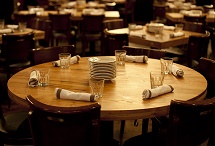 Old Barn Wood Co. uses reclaimed barn wood in its flooring and paneling. It also makes tables.
Old Barn Wood Co. uses reclaimed barn wood in its flooring and paneling. It also makes tables.
Montana Wood Designs’ Montana Lodge Reclaimed collection includes beds, dressers, tables, barstools, and chairs.
E&K Vintage Wood offers reclaimed wood including lumber, flooring, hand hewn beams, slabs, barn siding and custom milled furniture. The company also provides architectural services, finishing, and custom millwork. E&K wood is FSC certified and from old structures that include barns, warehouses, churches, homes, distilleries and cotton gins.
Vintage Flooring & Furniture manufactures different types of furniture, flooring and paneling from structures ranging from barns to homes to manufacturing plants. Some of the stories of its finds are on the company’s website.
GreenClaimed, a green building materials brand created by Cali Bamboo, recently released a new line of 100 percent reclaimed solid oak flooring. It is made in the United States and sustainably sourced by salvaging barns, factories and mills.
Impact Enterprises, maker of menu covers, binders and other items, utilizes wood from Lodgepole Pine in its products. The trees, infected by the Mountain Pine Beetle, are harvested before they fall, their integrity remaining intact. Harvesting of these infected trees before they fall provides open space and sunlight for emerging seedlings.
Glenn Hasek can be reached at editor@greenlodgingnews.com.






